
Anatolia, also known as Asia Minor, is a large peninsula located in West Asia and a region of Turkey, constituting most of its contemporary territory. Geographically, the Anatolian region is bounded by the Mediterranean Sea to the south, the Aegean Sea to the west, the Turkish Straits to the north-west, and the Black Sea to the north. The eastern and southeastern boundary is either the southeastern and eastern borders of Turkey, or an imprecise line from the Gulf of Iskenderun to the Black Sea. Topographically, the Sea of Marmara connects the Black Sea with the Aegean Sea through the Bosporus strait and the Dardanelles strait, and separates Anatolia from Thrace in the Balkan peninsula of Southeastern Europe.

Ionia was an ancient region on the western coast of Anatolia, to the south of present-day İzmir, Turkey. It consisted of the northernmost territories of the Ionian League of Greek settlements. Never a unified state, it was named after the Ionians who had settled in the region before the Archaic period.
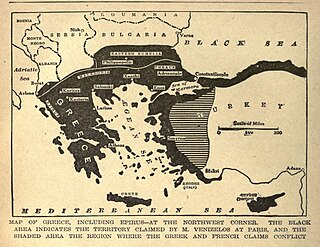
The Megali Idea is a nationalist and irredentist concept that expresses the goal of reviving the Byzantine Empire, by establishing a Greek state, which would include the large Greek populations that were still under Ottoman rule after the end of the Greek War of Independence (1821–1829) and all the regions that had large Greek populations.

The population of the Byzantine Empire encompassed all ethnic and tribal groups living there - Albanians, Arabs, Armenians, Assyrians, Byzantine Greeks, Bulgarians, Goths, Latini, Slavs, Thracians, Tzans, Vlachs and other groups. It fluctuated throughout the state's millennial history. The reign of the Emperor Justinian I in the mid-sixth century was the high point of the empire's expansion; however, the arrival of plague in 541 AD and its subsequent recurrences caused a severe depletion of the population. After the reign of Emperor Heraclius and the loss of the empire's overseas territories, Byzantium was limited to the Balkans and Anatolia. When the empire began to recover after a series of conflicts in the 8th century and its territories stabilized, its population began to recover. By the end of the 8th century the population of the empire was around 7,000,000, a figure that climbed to over 12,000,000 people by 1025 AD. The numbers began falling steadily to 9,000,000 people at 1204 AD and even lower to 5,000,000 people at 1282 AD with the arrival of the Turks.

The history of Greece encompasses the history of the territory of the modern nation-state of Greece as well as that of the Greek people and the areas they inhabited and ruled historically. The scope of Greek habitation and rule has varied throughout the ages and as a result, the history of Greece is similarly elastic in what it includes.
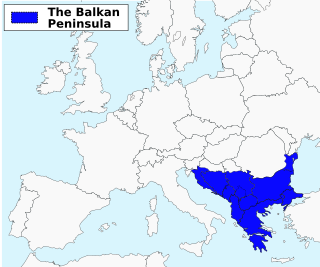
The Balkans and parts of this area may also be placed in Southeastern, Southern, Eastern Europe and Central Europe. The distinct identity and fragmentation of the Balkans owes much to its common and often turbulent history regarding centuries of Ottoman conquest and to its very mountainous geography.
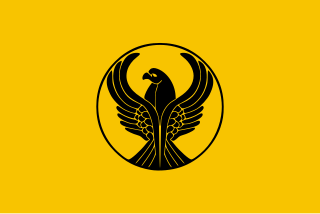
The Pontic Greeks, also Pontian Greeks or simply Pontians, are an ethnically Greek group indigenous to the region of Pontus, in northeastern Anatolia. Many later migrated in various waves between the Ottoman conquest of the Empire of Trebizond in 1461 and the Russo-Turkish War of 1828–1829. Common migratory destinations included other parts of Eastern Anatolia, the former Russian province of Kars Oblast in the Transcaucasus, and the country of Georgia.
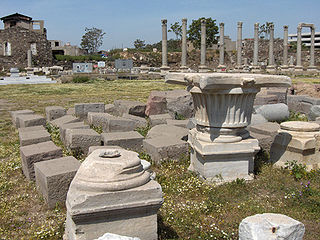
Aeolis, or Aeolia, was an area that comprised the west and northwestern region of Asia Minor, mostly along the coast, and also several offshore islands, where the Aeolian Greek city-states were located. Aeolis incorporated the southern parts of Mysia, and is bounded by it to the north, Ionia to the south, and Lydia to the east.

The Armenian highlands is the most central and the highest of the three plateaus that together form the northern sector of West Asia. Clockwise starting from the west, the Armenian highlands are bounded by the Anatolian plateau, the Caucasus, the Kura-Aras lowlands, the Iranian Plateau, and Mesopotamia. The highlands are divided into western and eastern regions, defined by the Ararat Valley where Mount Ararat is located. Western Armenia is nowadays referred to as eastern Anatolia, and Eastern Armenia as the Lesser Caucasus or Caucasus Minor, and historically as the Anti-Caucasus, meaning "opposite the Caucasus".

The 1923 population exchange between Greece and Turkey stemmed from the "Convention Concerning the Exchange of Greek and Turkish Populations" signed at Lausanne, Switzerland, on 30 January 1923, by the governments of Greece and Turkey. It involved at least 1.6 million people, most of whom were forcibly made refugees and de jure denaturalized from their homelands.

The Greek genocide, which included the Pontic genocide, was the systematic killing of the Christian Ottoman Greek population of Anatolia which was carried out mainly during World War I and its aftermath (1914–1922) on the basis of their religion and ethnicity. It was perpetrated by the government of the Ottoman Empire led by the Three Pashas and by the Government of the Grand National Assembly led by Mustafa Kemal Atatürk, against the indigenous Greek population of the Empire. The genocide included massacres, forced deportations involving death marches through the Syrian Desert, expulsions, summary executions, and the destruction of Eastern Orthodox cultural, historical, and religious monuments. Several hundred thousand Ottoman Greeks died during this period. Most of the refugees and survivors fled to Greece. Some, especially those in Eastern provinces, took refuge in the neighbouring Russian Empire.
Turkification, Turkization, or Turkicization describes a shift whereby populations or places received or adopted Turkic attributes such as culture, language, history, or ethnicity. However, often this term is more narrowly applied to mean specifically Turkish rather than merely Turkic, meaning that it refers more frequently to the Ottoman Empire's policies or the Turkish nationalist policies of the Republic of Turkey toward ethnic minorities in Turkey. As the Turkic states developed and grew, there were many instances of this cultural shift.
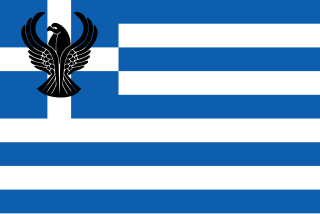
The Republic of Pontus was a proposed Pontic Greek state on the southern coast of the Black Sea. Its territory would have encompassed much of historical Pontus in north-eastern Asia Minor, and today forms part of Turkey's Black Sea Region. The proposed state was discussed at the Paris Peace Conference of 1919, but the Greek government of Eleftherios Venizelos feared the precarious position of such a state and so it was included instead in the larger proposed state of Wilsonian Armenia. Ultimately, however, neither state came into existence and the Pontic Greek population was massacred and expelled from Turkey after 1922 and resettled in the Soviet Union or in Macedonia, Greece. This state of affairs was later formally recognized as part of the population exchange between Greece and Turkey in 1923. In modern Greek political circles, the exchange is seen as inextricable from the contemporaneous Greek genocide.

The Byzantine Empire experienced cycles of growth and decay over the course of nearly a thousand years, including major losses during the early Muslim conquests of the 7th century.

The Byzantine–Ottoman wars were a series of decisive conflicts between the Byzantine Greeks and Ottoman Turks and their allies that led to the final destruction of the Byzantine Empire and the rise of the Ottoman Empire. The Byzantines, already having been in a weak state even before the partitioning of their Empire following the 4th Crusade, failed to recover fully under the rule of the Palaiologos dynasty. Thus, the Byzantines faced increasingly disastrous defeats at the hands of the Ottomans. Ultimately, they lost Constantinople in 1453, formally ending the conflicts.
Greek refugees is a collective term used to refer to the more than one million Greek Orthodox natives of Asia Minor, Thrace and the Black Sea areas who fled during the Greek genocide (1914-1923) and Greece's later defeat in the Greco-Turkish War (1919–1922), as well as remaining Greek Orthodox inhabitants of Turkey who were required to leave their homes for Greece shortly thereafter as part of the population exchange between Greece and Turkey, which formalized the population transfer and barred the return of the refugees. This Convention Concerning the Exchange of Greek and Turkish Populations was signed in Lausanne, on January 30, 1923 as part of the peace treaty between Greece and Turkey and required all remaining Orthodox Christians in Turkey, regardless of what language they spoke, be relocated to Greece with the exception of those in Istanbul and two nearby islands. Although the term has been used in various times to refer to fleeing populations of Greek descent, the population strength and the influence of the Asia Minor Greeks in Greece itself, has attached the term to the Anatolian Greek population of the early 20th century. At least 300,000 Greek refugees were from Eastern Thrace, whereas at least 900,000 were from Asia Minor. At least 150,000 were from Istanbul, who left the city in three years before 1928.

The North Aegean islands are a number of scattered islands in the North Aegean Sea, also known as the Northeastern Aegean islands, belonging mostly to Greece and a few of them to Turkey. The islands do not form a physical chain or group, but are frequently grouped together for tourist or administrative purposes. To the south are the Dodecanese islands; and to the west are the Cyclades and Sporades islands.

Ottoman Greeks were ethnic Greeks who lived in the Ottoman Empire (1299–1922), much of which is in modern Turkey. Ottoman Greeks were Greek Orthodox Christians who belonged to the Rum Millet. They were concentrated in eastern Thrace, and western, central, and northeastern Anatolia. There were also sizeable Greek communities elsewhere in the Ottoman Balkans, Ottoman Armenia, and the Ottoman Caucasus, including in what, between 1878 and 1917, made up the Russian Caucasus province of Kars Oblast, in which Pontic Greeks, northeastern Anatolian Greeks, and Caucasus Greeks who had collaborated with the Russian Imperial Army in the Russo-Turkish War of 1828–1829 were settled in over 70 villages, as part of official Russian policy to re-populate with Orthodox Christians an area that was traditionally made up of Ottoman Muslims and Armenians.

The history of Turkey, understood as the history of the region now forming the territory of the Republic of Turkey, includes the history of both Anatolia and Eastern Thrace. These two previously politically distinct regions came under control of the Roman Empire in the second century BC, eventually becoming the core of the Roman Byzantine Empire. For times predating the Ottoman period, a distinction should also be made between the history of the Turkic peoples, and the history of the territories now forming the Republic of Turkey From the time when parts of what is now Turkey were conquered by the Seljuq dynasty, the history of Turkey spans the medieval history of the Seljuk Empire, the medieval to modern history of the Ottoman Empire, and the history of the Republic of Turkey since the 1920s.

Cappadocian Greeks, also known as Greek Cappadocians or simply Cappadocians, are an ethnic Greek community native to the geographical region of Cappadocia in central-eastern Anatolia; roughly the Nevşehir and Kayseri provinces, and their surroundings, in modern-day Turkey. There had been a continuous Greek presence in Cappadocia since antiquity, and the indigenous populations of Cappadocia, some of whose Indo-European languages may have been closely related to Greek, became entirely Greek-speaking by at least the 5th century.

















